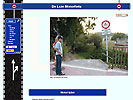In the United Kingdom they are called born-again bikers: people with a motorcycle past, who want to take up riding again.
If you rode a motorcycle, long ago, and now, after years without a bike, you want to take up riding again, there are some risks to keep in mind.
The same applies, to a lesser degree, to motorcycle riders who stop riding in the winter and start riding again in the spring.
On this page, we have gathered some tips and advice to start riding again safely.
![]() Er is een Nederlandse versie:
Er is een Nederlandse versie:
https://www.luiemotorfiets.nl/tips/heropstappen/
A second motorcycle life
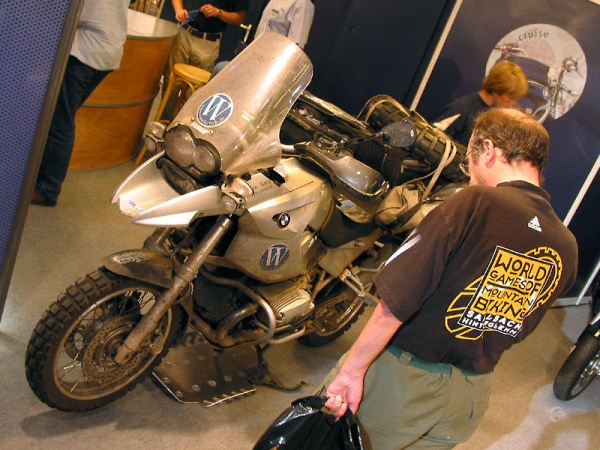
The motorcycle forgotten
It happens a lot, it's how life is:
After a couple of wild motorcycle years, you get a family, and
riding your bike becomes more and more difficult. There is no time,
the business suit doesn't fit under the motorcycle gear, the diapers
and the milk require a car, and the children eat a big part of the
family budget.
You need a bigger family car, and the motorcycle doesn't fit in the garage anymore. A lack of time, money and space chases the bike away. That's life.
It keeps nagging
But with most motorcycle riders, a little voice keeps nagging them.
When you drive your car in congestion, and you see motorcycle riders pass you, lane splitting, you know: once, you rode in their place. And what's more: you could ride there *now*, if you would have a bike.
The children grow, you earn more, and slowly, all the obstacles that made you sell your motorcycle disappear.
Starting to ride again
Whenever you want, you can enter a motorcycle shop, buy a bike, and hop on.
Born-again Bikers
, they're called in the United Kingdom.
Learning
The problem of starting to ride again, after a long pause, is that so much has changed. Traffic has become more congested, motorcycles are almost incomparable with the bikes of yesterday, and in countries where there is an exam, the requirements to pass are much higher.
At this moment, people who start riding again after years without a motorcycle, have a very high risk, compared to younger motorcycle riders, to have an accident.
Therefore, we would like to give some tips and advices to start riding again in a safe way, giving you optimal fun.
What's different: traffic
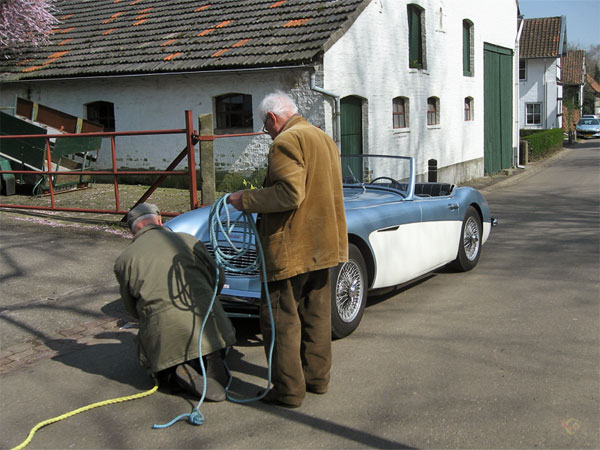
Congestion
In the first place, there is simply more traffic on the road.
When you drove your car, you got used to it, of course, but it's a difference, driving through busy traffic by car or on motorcycle.
In a car, you will not be easily overlooked by someone taking a left turn (or a right turn in countries where you drive on the left); on a motorcycle, it happens all too often.
Safer
Probably the biggest difference ois that traffic has become safer (at least in Western Europe).
It seems an advantage, and of course it is, but it is also a disadvantage if you pick up riding again after years of absence.
Some of the increased safeness stems from the layout of roads, but a big deal of the safety is caused by a better education of new motorcycle riders.
Driving your car, you, so to speak, grew along with the better behaviour of people on the road, but when you step on your motorcycle for the first time after those years, you only have the way you used to ride in your reportoire.
What has changed: motorcycles

Power
There are huge differences between the motorcycles which are made now, and those of bygone years.
In the first place there is power. Almost every motorcycle you can buy today has more power than bikes which were used in the MotoGP of twenty years ago.
For a long time, the amount of horsepower was one of the most impirtant numbers in a specification. The higher the amount, the more attractive the motorcycle was for potential buyers.
For some types of motorcycles, the trend has been changed a bit, but even
so, the ordinary
motorcycle at the dealer still has an enormous amount of Hp
compared to the ordinary
motorcycle of years ago.
Sportbikes, which are still sold often, almost have reached one Hp per kilogram, which is incredibly much.
Brakes
When you take a test ride on such a new motorcycle, and you use the brakes for the first time, you will be surprized by the braking force. With one finger on the brake handle, you will brake harder than you used to, using your whole hand.
Motorcycles with drum brakes are not produced anymore (at least, that we know of).
So you will have to learn to brake properly almost from scratch: build up brake force and squeeze through feels completely different in current bikes.
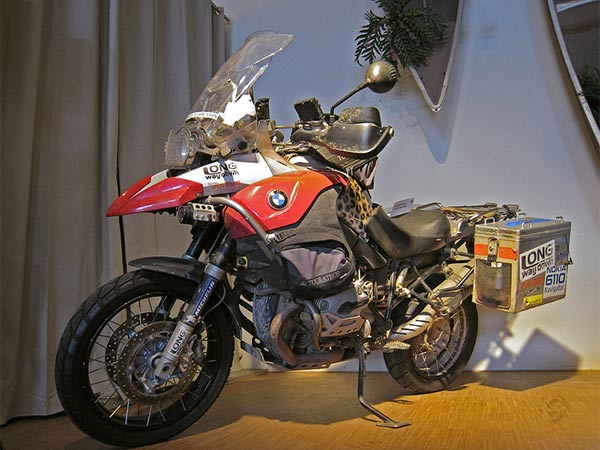
ABS
An increasing number of motorcycles has ABS these days. If you buy one, it doesn't mean that you won;t have to practise braking: there are costly meters between braking well and grab the brakes and have the ABS do the rest!
Height and weight
Another development is that motorcycles tend to become larger and heavier.
There still are many sportbikes, for which small weight and height is an advantage, but the BMW R1100GS has set a new trend.
Those higher and heavier motorcycles are not optimized for topspeed, but for comfort during long trips, and for usefulness on different types of roads (including unpaved roads).
Most of those bikes never leave the tarmac, and only few of them (but increasingly more) experience a world trip, but the more a motorcycle seems to invoke the idea of being able to go tour the world any moment, the higher the sales numbers.
Useflness on different types of road is a big advantage. The fact that the trend towards more Hp's and more power has gone into another direction is a good development for motorcycle riders.
Unfortunately, instead of that trend, there is a new development toward bikes getting higher, bigger, heavier, and awe inspiring.
What is different: the exams
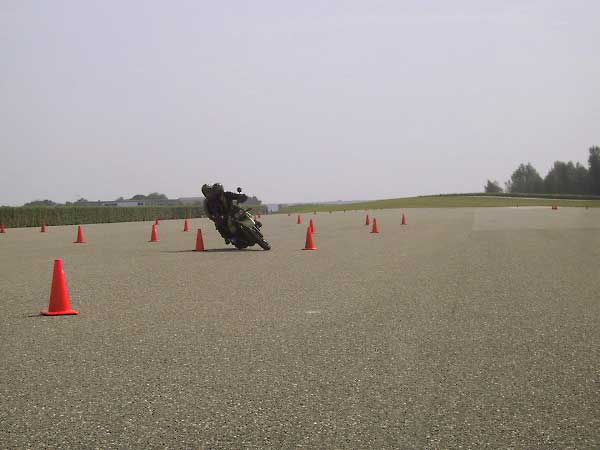
In the old days
In many countries where you have to do an exam to be allowed to ride a motorcycle, this is only recently so. And if having to pass an exam has been necessary for a long time, it has become more difficult to pass it.
Braking
An example is formed by the braking exercises in the Dutch exam.
A few years ago, you had to perform a so-called precision stop, which meant that you had to use the back and the front brake in the right way, and you had to switch gears so you would be in first gear when you came to a standstill, with one foot on the ground.
Right now, there are three kinds of braking exercises in the exam, and one of them is an emergency stop on a relatively high speed.
Tight Maneuvring
The same applies to the figures of eight etc you have to show: these days, the exercises include slaloming at a higher speed, in which you should show that you can lean in the bike by using your hips not only at walking speed, but at motorcycle-speed as well.
Looking and anticipateing
Another difference is that you have to show you can look ahead to pass the exam: when you spot a red light, you should go off the throttle, so you won't need the brakes. It means that you will have to use the brakes only seldomly.
So motorcycle riders who have begun recently, often have learned a lot more than motorcycle riders who started riding years ago, and have not been riding for a while.
Starting again: which motorcycle?
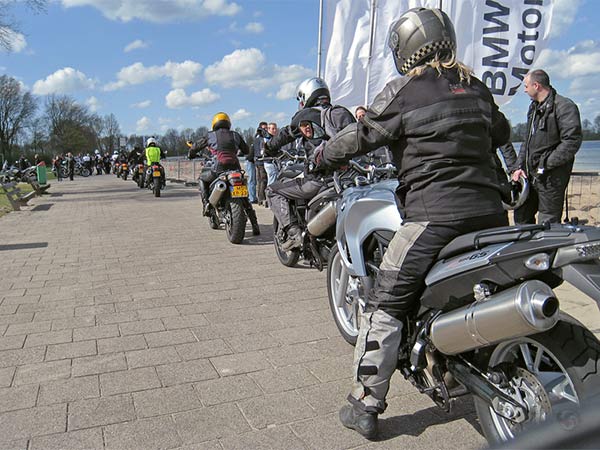
Heavy and big and fast?
It is tempting to buy a heavy, big and powerfull motorcycle. After all, you are an experienced motorcycle rider, and you probably have many kilometers under your wheels.
What's more, you often have the money to buy the bike that appeals to you, so why would you buy something else?
It is a difficult message, but often, it is advisable to take the time to freshen up your riding capabilities first, and the best way to do that is to use a motorcycle which is not heavy, big, powerfull and fast.
Motorcycles for beginners
Our page on motorcycles for beginners explains which properties determine whether a motorcycle is optimized to minimize the learning curve.
The very best advice is to start on such a bike, when you didn't ride for a couple of years.
The term beginner's bike
is, in fact, a wrong one: most motorcycles
which are recommended for beginners nowadays, are far more powerfull than
most motorcycles from the past.
Most beginners bikes
, will be able to give you everything you want
from a bike for the rest of your life.
Start riding again: lessons
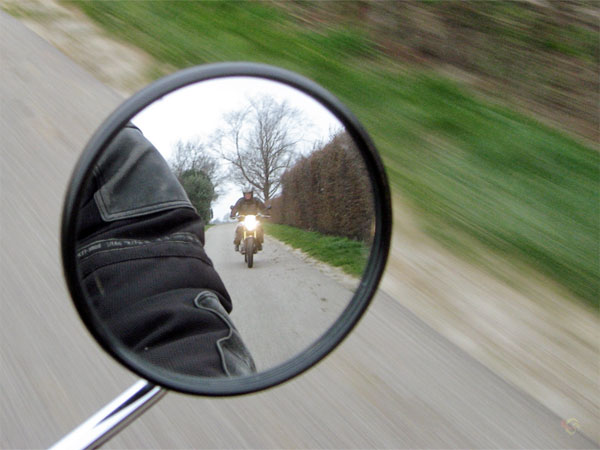
Catch up lessons
It would be overdone to try to pass the exam for the second time, but it is a very good idea to take a few lessons before you go out riding on your own.
Riding schools often offer special lessons for those who start riding for the second time, after many years. Sometimes, there is a take-in, after which they can tell you what they think you need, and how much it would cost.
Training for advanced riders?
A training for advanced riders is advisable when you have taken up riding again, and ride for about a year. Such a course is no substitution for riding lessons: it is an addition, after you have gained some experience again.
The best sequence is to take lessons, then ride for about a year regularly, and then take an advanced rider's course.
Insight
The most important aspect of those lessons is that someone else gives
feedback on your riding habits. It is very difficult to discover your
own imperfections; stranger's
eyes, which are trained, ar far better
at it.
Starting to ride again: practice
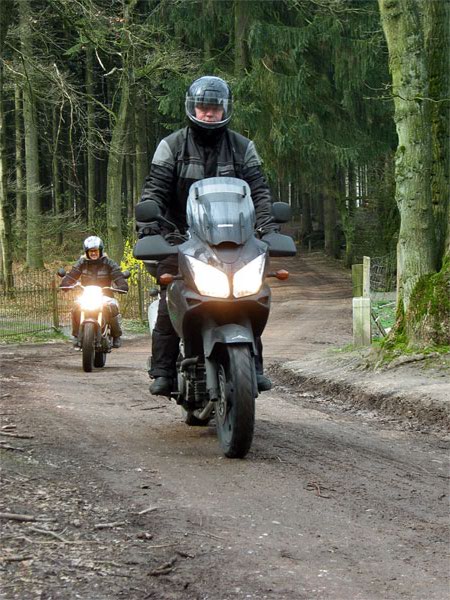
Braking
When you have followed a few lessons, and have bought your own bike, the best thing you can do is search a large empty space, and start practise your braking skills.
Even if you could perform perfect braking exercises during the lessons you took before buying your new bike, it's better to repeat them on your own bike, because every motorcycle behaves different.
Also with ABS!
Having ABS doesn't mean that you wouldn't need to do brake exercises.
In a car it may be sufficient to slam the brakes, but on a motorcycle you loose too many valuable meters, when you brake in such a way.
Our page about braking explains about how to minimize your braking distance.
Off road
An off-road course will also help to make you more familiar with your bike, even when you (preferably) do it on a bike you get for the course.
You will learn, among other things, to have the motorcycle move every which way underneath you, and staying upright all the same.
After a winter break
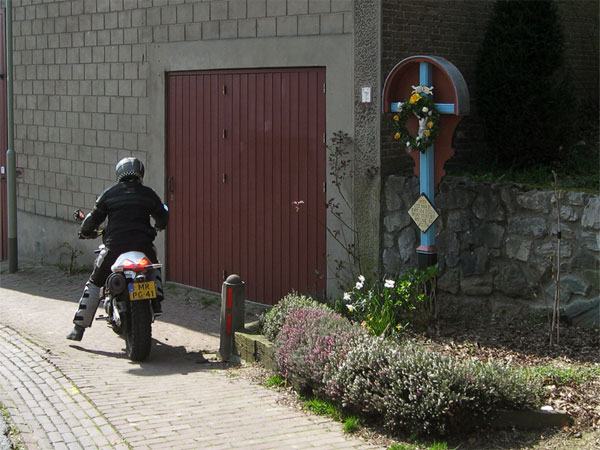
First trip
On the first beautiful saturday or sunday in spring, a lot of motorcycle riders who have stopped riding during the cold winter, come out on the road, for the first time since last autumn.
The police calls those days black saturday
or sunday,
because on such days, there is a peak in accidents of motorcycle
riders.
If you are used to stop riding during winter, it's important to remember that your riding capabilities are not like they were during last autumn from the moment you get on your bike.
Practice
So try to practise first, on such a day, especially when you ride in a group.
Just reserve an hour before you start riding, and practise some brake exercises, to fget into shape again so to speak.
Your first ride will be the better.
New motorcycle

Risk
Statistically, most motorcycle-related accidents happen during the first couple of months with a new motorbike, and this is even true for experienced riders.
Getting used to a motorcycle takes attention, which means you have less attention for the traffic around you as on a motorcycle with which you have years of experience.
Practise
So after having bought a new bike, consider your self a bit of a beginner, take the time to get used to it, and realise that you will have to keep it easy for the first couple of months.
And try to do some brake exercises from time to time: you will earlier feel familiar with your bike.
Comments, Q & A, on a separate page




